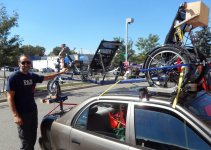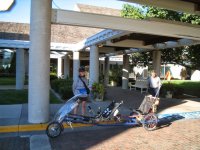Here's a report on our first test tour with the new electric assist system. Once again, I added to my recumbent tandem delta trike a Bafang SWXK 250 watt geared hub motor and a Ping LiFePO 20 Ah, 36 volt battery. I've also got the CA version 3 to help me keep track of battery usage and so forth. The hub motor is laced into a 16 inch front rim. I use a thumb throttle to engage assist when needed.
Our trip was 257 miles over 8 days (2 days off, toward the middle, while my wife attended a conference along our route). Overall, the tour was a huge success. The bike carrier I cobbled together for our ungainly rig (8.5 foot wheelbase, 33" width)--which consists in a strap-down roof rack on which the back wheels sit and a standard trailer hitch bike rack behind, which I modified to hold the front wheel--performed flawlessly. The electric assist kit was a huge improvement over our former, DD motor/kit. The terrain we covered was quite flat (southern Ontario, CA, northeastern OH, USA, and southeast MI, USA), but I'm quite optimistic that even in more hilly or even mountainous terrain, the kit would perform well also. We drove the bike from our home in WI across MI and had our friend drop us off in southern Canada, from whence we biked (and ferried) back to MI.
As mentioned, the assist is mainly for help getting up hills, but it has the added benefit of helping us keep a slightly faster pace when, for example, riding into unfavorable winds. Our longest day was a mere 57 miles, while the shortest was about 37. The CA showed that we used 24.8 amp hours of battery over the 257 mile journey. So the average per mile was about .096--close to .1 amp hour per mile or 1 amp hour over 10 miles.
There was a fair amount of variation by day in how many amp hours we used, dependent, I think, on wind/hill conditions. On the final day, which was our shortest day, for example, we used around 6 amp hours to go 37 miles. By contrast, on our 57 mile day, we used 6.5. On that final day we did have a headwind, so I was using the assist quite a lot to help us maintain about a 12 mph pace. That was also the day on which we encountered the hilliest portion of our route (hilly by flat, midwestern standards).
That said, the trip was really a huge success, and I was quite gratified that everything came together so well (and that the weather was pretty agreeable). Thanks loads to all who contributed to this thread and who have advised me in other threads on this forum. I couldn'a done it without ya!
A final query: just how many amp hours can I drain from my battery before I run the risk of damaging it unless I recharge? Or, in general, how do I tell when it's reached that point?







